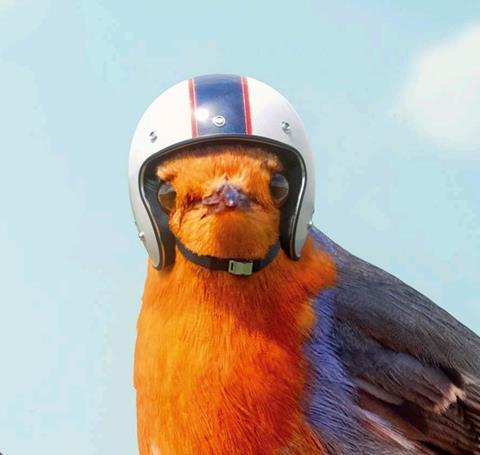Phil Brown explores the case for policymakers and building designers to follow North America’s lead in making buildings safer for birds

Glass continues to be a material of choice to adorn the skyline as our cities grow larger and taller.
Glass-cladded buildings give design appeal with a modern edge, while attributes like solar control, thermal efficiency and self-cleaning coatings benefit a building’s performance.
Yet for all the benefits of glass, it can create a risk for birds.
Many birds are unable to use visual signals such as window frames to distinguish the location of the glass, making them prone to colliding with buildings in their path when in flight.
Birds striking windows represents one of the largest human-made causes of bird mortality and it’s an issue that’s beginning to draw attention from policymakers around the world.
America has made early strides towards protecting birds in dedicated building regulations. But such conversation on bird safety has flown under the radar in the UK’s building design industry, despite specialist bird-safe glazing being readily available.
However, there’s a good opportunity for change as the narrative around sustainable building design expands beyond energy efficiency, with more designers considering how their projects can sustain biodiversity in urban environments.

Policymakers and the building design community could follow the United States’ example in protecting birds, by utilising and encouraging the specification of bird-safe glazing in projects.
Birds striking buildings is not a case of bad bird eyesight. Most avian species’ eyesight is sharper than our own, but in addition to visible wavelengths, they see the world through UV rays of varying wavelengths that are virtually invisible to the human eye, meaning they do not see reflections in the way we do.
It’s also not an issue isolated to skyscrapers. Buildings of all sizes can cause bird fatalities. Berlin Brandenburg Airport revealed that 50 dead birds have been found close to the glazed terminal in its first year of operation.
Albeit skyscrapers grab the headlines when it comes to bird deaths and as a result, have been the genesis of policy protecting birds.
The state of New York passed a bill in 2019 to ensure all new glass buildings are safer for migratory birds after a volunteer found over 200 dead birds on pavements around the World Trade Centre. It requires structures over 23 metres to be patterned to make them more visible.
Now, thanks to the specification of dotted glass across its facade, New York’s Javits Centre, a 760,000 sq ft exhibition hall made almost entirely of glass – previously responsible for the most bird deaths each year in New York – has reduced bird collisions by 95%.
It’s also not an issue isolated to skyscrapers. Buildings of all sizes can cause bird fatalities.
Originating from the Leadership in Engineering and Environmental Design’s “reducing bird collisions” programme, legislation in North America protecting birds colliding with glass exists at three levels: federal, regional and municipal.
Canada has been recognised as the first Northern American country to address the issue, sitting on a path of two major avian migration routes. Bird-friendly building design became Canadian law in 2009, requiring patterned manifestations on glass elevations. Those that have already retrofitted their buildings for compliance claim fatal bird strikes have decreased by more than 90%.
Increasing public awareness, political will and desire from developers in Canada has led to action to protect birds more widely across North America.
While this illustrates what can be achieved with the support of specific legislation, there is a question as to whether domestic developers have the appetite to adopt similar measures.
British ornithology reports that 100 million strikes occur in the UK per year, with one third dying as a result. It has even been said to be a cause for decline in UK avian population.
Despite this, the UK is yet to explore bird-safe building regulations.
The building design industry and its supply chain have the capacity to drive positive change and protect birds. Material solutions to bird strikes have existed for years, in the form of printed glass or specifying anti-reflective glazing and recessing it into facades. However, many in the industry have been reluctant to employ these fixes given the compromise on building aesthetics, performance, and end-user experience.
However, advances in glazing mean that we can now safeguard bird populations without compromising on the reasons why glass is a material of choice for architects.

Specifying specialist bird-safe glass is a natural choice for architects working on projects linked so closely to nature, including housing projects or visitor facilities in conservation areas. But there’s a great opportunity for designers to utilise advances in glass in more urbanised city landscapes that are still home to thousands of birds, under the broader interest of sustainable building design.
Making buildings truly sustainable goes beyond emissions and energy efficiency. Architects and specifiers increasingly need to consider how their projects impact local wildlife too.
Solutions like UV patterned glass enable architects to enjoy the aesthetical and performance enhancing benefits of advanced glass, such as solar control or thermal insulation, while creating buildings that protect birds.
By 2025, it is expected that two-thirds of the world population will be living in urban areas. And avian populations will be coming under increase threat from other factors like bird flu. However, with the right products and knowledge in place, architects and specifiers can play a key role in ensuring the built environment can co-exist with the natural world and the creatures that inhabit it.
Postscript
Phil Brown is technical advisory service manager (UK & Ireland) and European regulatory marketing manager at Pilkington United Kingdom Limited, part of the NSG Group
















No comments yet